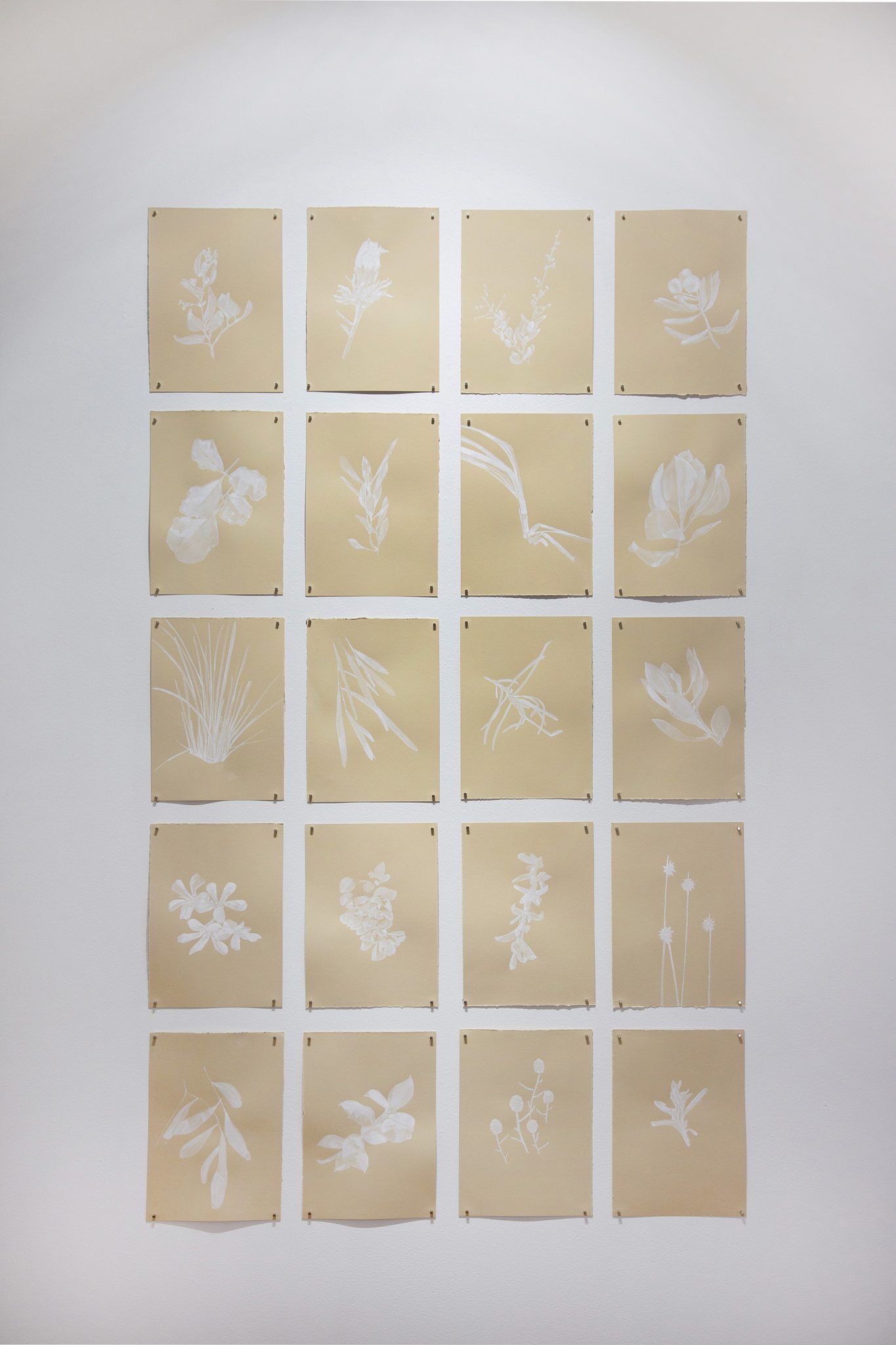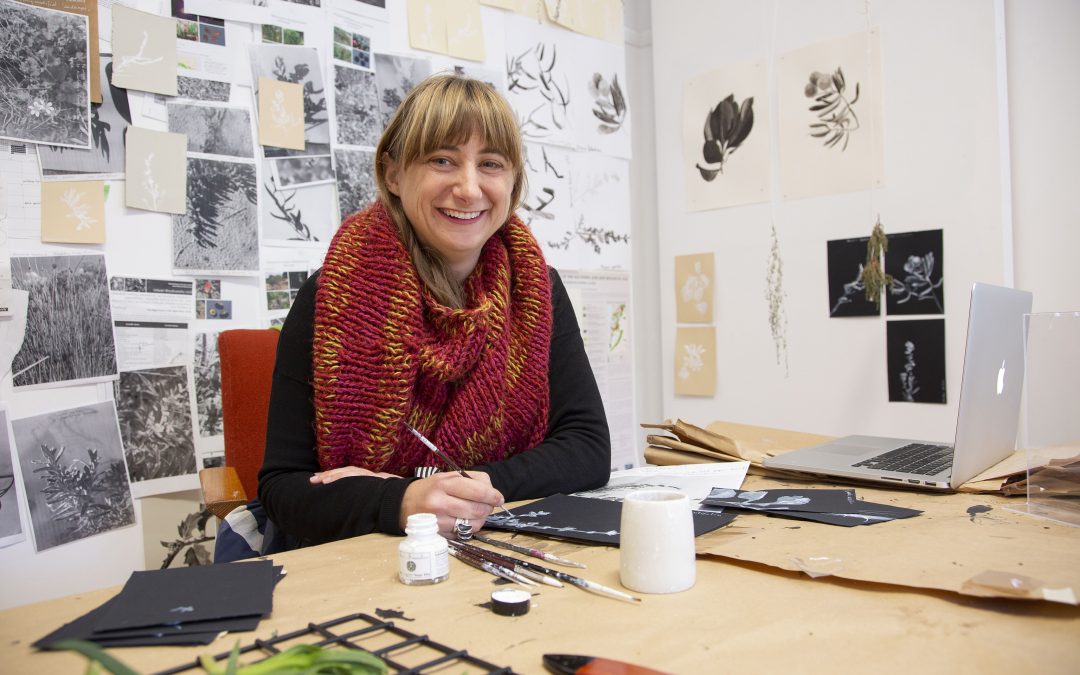Image: Louise Flaherty. Photograph: Craig Arnold.
Louise Flaherty is known for works that are inspired by the original flora of the Adelaide plains and informed by community engagement. Her dunes (2019) is included in Our Future in the Landscape, an exhibition that explores urban and ecological responses to climate change. In this interview with curator Steph Cibich she discusses the artwork and the driving force behind her practice.
Our Future in the Landscape is presented as part of the ART WORKS 2020 Emerging Curator Program, delivered by Guildhouse in partnership with the City of Adelaide.
How would you describe your practice and your approach to making a body of work?
My practice is inspired by the natural environment around me and specifically it is focused on researching the original plants and landscapes of the Adelaide Plains. This has been the basis of my long-term project Memorial for Forgotten Plants. My work details the native flora across many different suburbs and ecosystems of Adelaide. Drawn with ink on paper, my work reflects the loss and sadness of native plants from our suburban landscape, highlighting native plant conservation.
I approach my work in a methodical and perhaps scientific manner (although I do not have a scientific/botany background – I am a novice and learning along the way). The area of Adelaide had about 21 different ecosystems all with varying flora (e.g. coastal areas, grasslands, areas along rivers etc.). I pick one area to focus on and look up the list of plants that were in that area. As a starting point, I work through the list of plants and start drawing each plant using white ink on black paper. If I can, I draw from photographs I have taken of plants, but mostly I work using the online database Seeds of SA database, which has photographs of all native flora in South Australia. I use this database because sometimes it is hard to find the plants growing.

Image: Lousie Flaherty, dunes, 2019. Photograph: Craig Arnold.
Can you briefly describe the work dunes (2019) featured in this exhibition and the ideas that led you to make it?
The work dunes is slightly different to my usual method of working. This work came about while undertaking an Artist in Residence at Sauerbier House in Port Noarlunga. During the residency I made one piece in response to a list of coastal plants that once grew in the area. The other piece I made was dunes. This work came about while exploring the dunes at Port Noarlunga, over the 3 months I was getting to know the plants that still grew in the dunes. I was photographing them all, and I learnt most about the dunes by joining and volunteering with the local Trees for Life group that look after the site. By working with the group I was able to learn and identify the plants in the dunes. This work was made up of all the plants I was able to find and identify in the Port Noarlunga dunes. The work was also made to celebrate and honour the work that the volunteers do for this site. I did not use black in these works because this work was more of a celebration to what is there as opposed to a memorial of what is no longer there.
The work was made during your residency at Sauerbier House, did you come away from that residency with a new focus or insight into your practice?
The residency at Sauerbier House was a wonderful experience to have a 3 month dedicated space and surrounding environment to respond to. Like any residency it is fuel for your practice, not just for that 3 months but for a long period after. One of the things that I got out of my time spent there was to also look at what there was to celebrate, rather than focusing on the sadness of what has been lost and forgotten but to focus on some positives and celebrate what people are doing to support these ecosystems.
How do you think dunes (2019) reflects or challenges urban and ecological responses to climate change?
I hope that the work is a reminder of all of the wonderful local native plants that can grow in the coastal dunes, which is a particular harsh environment. I hope that it assists people in thinking about their local environment where they live and assists in helping to make decisions about what they might grow in their backyard. By looking at what used to grow in your local area you are choosing plants that will grow well there and also need less water to survive. I hope that my work generates curiosity for people to explore and go not their own journey of finding out what plants used to grow where they live and explore what will work for them in their own backyard.
Much of your practice incorporates community engagement. What inspired you to integrate this into your practice and what value do you think it adds to your work?
I have a passion for making art accessible for all and I like the idea of taking art out of an art gallery space to increase engagement in the work. I hope that by incorporating community engagement – workshops – into my work it gets more people engaging with it. My hope is to get more people who may not necessarily come along to galleries to engage.
About 10 years ago I was working as an Arts program manager for Barkly Regional Arts and it was our remit to deliver community driven arts programs to Tennant Creek and surrounding communities. While working intensively developing programs in response to community needs and requests, I was able to see the value of art as a tool for wellbeing in the community, both socially and economically. I specifically worked in developing projects that were accessible and enabled the whole community to get involved and participate. It was a learning curve of working with community and what works and what doesn’t. Moving back to Adelaide and re-establishing myself as an artist after having children, one of my main aims in my own practice was to always try and include an element of community engagement and to also try and include some of the practice to be outside of the gallery space. I am not quite there yet, but I am constantly learning and developing the way I work. The Guildhouse Limber Up mentorship I undertook in 2018 with Laura Wills really assisted in developing this aspect of my practice. It’s a work in progress!
I also believe that the arts can play a valuable role in education of current issues we are facing, especially in regard to climate change and the environment. I believe that artists can generate discussions in an accessible way.
Your Memorials utilise repetition and highlight the intricate, lesser known details of native plants. What makes you want to commit a plant’s details to memory?
In the first instance it is purely on a selfish level – I want to teach myself how to identify as many local plants as possible. It’s almost like a life project of mine. By working the way I do, in slowly working through a list and getting to know the details of each plant, I am committing these details to memory. I have a long way to go, but slowly I am knowing more and more plants. I still struggle to remember the botanical names, but I am making progress. I hope that by having this knowledge when I am engaging with the wider community, I can also impart some curiosity of plants on to others and show people the beauty of these plants so that more people might be interested in growing these in their own backyard.
How do you think your work connects with the space and location of the Adelaide Town Hall?
I was a bit worried that it doesn’t connect as well as my work about a site down south at Port Noarlunga. If I had it, I would have loved to have shown work that related to sites in the Adelaide CBD. I feel like that would have related better to the site and location of the Town Hall. But, I also hope that it does generate some conversation and thoughts about our local native plants species in the region.
The exhibition is titled Our Future in the Landscape, which draws attention to the challenges facing our future as we know it. Do you find this concept disheartening, or do you prefer to view the current climate crisis as an opportunity to bring communities together?
I do feel a little bit of both. Sometimes I do feel worried and disheartened about the future of our landscape, but then I also feel like it is an opportunity to bring communities together. I saw that a bit when I was working at Sauerbier House and working with the local Trees for Life group. I was heartened to meet locals from all walks of life coming together and working to look after the coastal dunes.
Our Future at the Landscape is showing at Adelaide Town Hall until Friday 26 June. As a result of the COVID-19 outbreak, the City of Adelaide have advised that the Adelaide Town Hall will be closed to the public until further notice.
Louise Flaherty
Louise Flaherty is an artist and arts worker based in Adelaide and holds a Bachelor of Visual Arts with Honours from the South Australian School of Art. Flaherty’s work is inspired by the original flora of the Adelaide Plains in a project titled Memorial for Forgotten Plants. Her practice develops ink drawings and plant material installations detailing the native flora across the many different suburbs and ecosystems of South Australia. These works reflect on the loss of native plants from our landscape and the resultant sadness. They also celebrate the native flora that thrives and the folk who champion their continued existence. Alongside her practice, Flaherty engages community members to explore their own take on the subject through facilitated workshops.
This body of work was developed through Flaherty’s residency at Sauerbier House and responds to her meeting the Trees for Life group, who look after the dune systems in the Port Noarlunga region.


